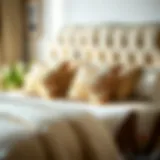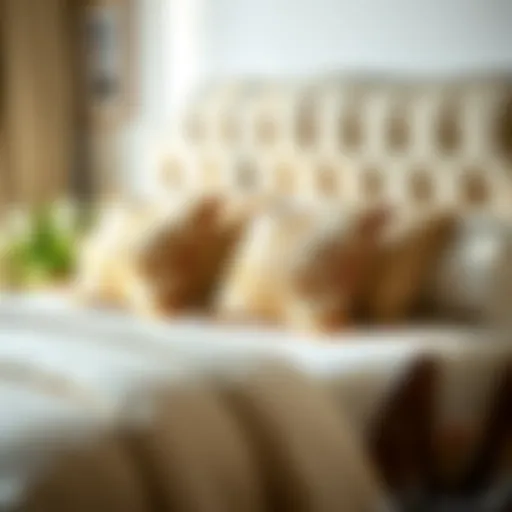Creative Uses for Plain Coasters in Crafting Projects
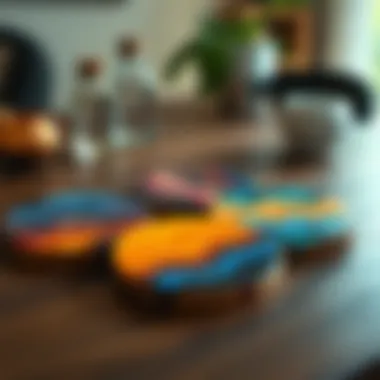
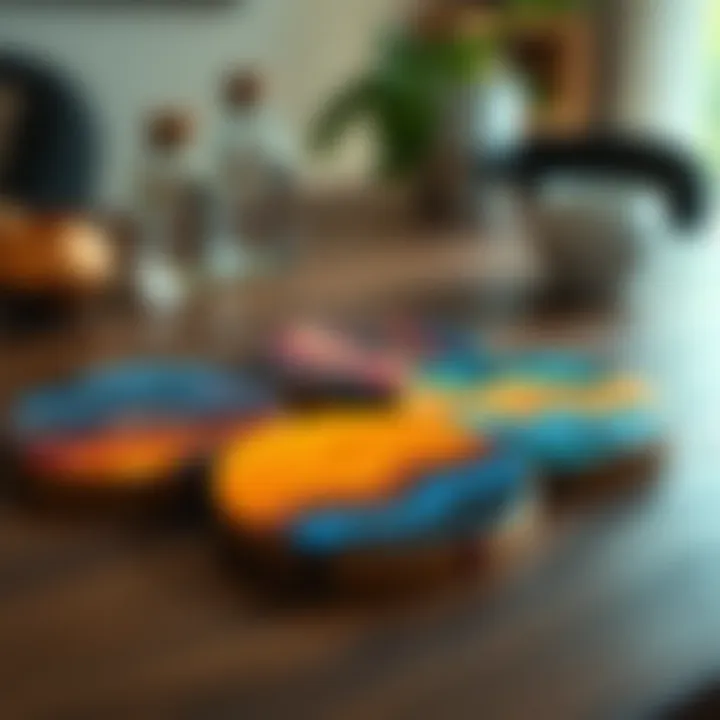
Intro
Crafting has always served as a canvas for personal expression, and plain coasters might just be the underrated gems of this creative world. These unassuming squares or circles, often lurking in the corners of cafes and homes alike, stand at the ready to be transformed into something extraordinarily personal. In a time when customization is king, coasters serve not just as functional items, but also as a blank slate for a myriad of artistic endeavors.
The variety of materials used to create coasters—from cork to wood, ceramic to resin—opens the door to numerous crafting possibilities. Each material offers a different texture and flexibility, impacting the crafting techniques available to creators. For those who hold a passion for both aesthetics and functionality, the ability to transform a simple coaster into a masterpiece is an exciting journey.
Crafters can delve into various methods—from painting and decoupage to resin pouring and stamping. The options are as diverse as the personalities behind the projects, allowing for customization that reflects individual tastes and styles. This article aims to illuminate the pathways available for using plain coasters as a medium for creativity, proving that these simple items can indeed lead to extraordinary results.
For the fashion enthusiasts and boutique owners, exploring the latest trends in coaster crafting can also provide ideas for home decor or unique gifts that resonate with customers. The fun doesn’t stop at personal projects; it extends into retail possibilities as well.
So, let’s dive into the fabulous world of plain coasters and explore what you can do with them.
The Basics of Coaster Crafting
Crafting with coasters might seem simple at first, but understanding the foundational aspects can amplify your creativity and elevate your projects. Many crafters start with plain coasters as a blank canvas, ready to be transformed into personalized pieces of art or functional décor. This basic knowledge about coaster crafting sets the stage for various customization techniques, exploring the rich potential that these everyday items hold.
Understanding Coaster Materials
When delving into coaster crafting, the material choices you make can have a significant impact on both the durability and aesthetic of your creations. Here’s a closer look at popular materials:
Wood Coasters
Wood coasters are a popular choice among crafters due to their natural beauty and durability. One key characteristic of wood is its ability to absorb moisture, making it practical for preventing water rings on surfaces. Pine or birch wood, for example, offers a smooth surface that can easily be painted or engraved, allowing for both intricate designs and simple monograms.
However, there's a caveat: wood can warp or crack if not properly sealed or maintained, especially when exposed to moisture over time. Therefore, careful selection of finish and sealants is crucial to optimizing the longevity of wooden coasters in crafting.
Cardboard Options
Cardboard coasters present a lightweight, economical option for those who may be just starting out. They are often made from recycled materials, contributing to sustainability in crafting. Their versatile nature allows crafters to easily cut and shape them, making cardboard an ideal choice for seasonal or themed projects.
Despite their benefits, cardboard coasters have limitations. They are not as durable as their wooden counterparts and can quickly become soggy if used with wet beverages. Thus, while great for temporary designs or experiments, they may not be suitable for long-term use.
Cork Variety
Cork coasters bring a unique texture and inherent water resistance to the table, which is a big plus in any crafting scenario. Their porous nature makes them great at absorbing moisture, keeping surfaces safe from potential damage. The earthy tones of cork also provide an aesthetic appeal that complements various decorative styles.
On the downside, cork can be more challenging to paint or decorate compared to wood and may require specific paints or adhesives that are compatible with its texture. This can add complexity to projects aimed at making cork coasters more personalized.
Stone and Ceramic Choices
Stone and ceramic coasters are often favored for their robustness and elegance. These materials lend themselves to ornate designs and sophisticated finishes. They're easy to clean and can withstand high temperatures, making them practical for hot drinks. A distinct advantage of stone is its low water absorption, thus avoiding the risks of moisture-related damage.
However, they can be quite heavy and fragile, making them less portable than other materials. A dropped stone coaster could leave you with a mess to clean up, and so careful handling is a priority. Nevertheless, when chosen for the right project, stone and ceramic coasters can result in stunning pieces that showcase your craftsmanship elegantly.
Essential Tools for Crafting
Equipping yourself with the right tools can make all the difference in your coaster crafting journey. Using the correct implements can enhance your precision and efficiency, ultimately leading to higher-quality results. Here’s an overview of essential tools you might consider:
Cutting Tools
Cutting tools are crucial for shaping materials accurately to get the perfect dimensions for your coasters. Utility knives and scissors are common for softer materials like cardboard and cork. Precision cutting tools, like jigsaws or laser cutters, can provide clean edges in wood or ceramics, perfect for more intricate designs.
While these tools can make your work easier, they also demand skill and safety precautions. Always keep safety gear like gloves or goggles nearby, as accidents with sharp tools can lead to serious injuries.
Adhesives and Sealants
The right adhesives and sealants are integral for ensuring your coasters hold together and resist wear. PVA glue is often a go-to choice for wood; it dries clear and is easy to work with. For fabric or paper decoupage, mod podge is highly recommended as it serves as both an adhesive and a sealant.
One consideration with adhesives is their drying times and strength. Make sure to choose the appropriate adhesive for your material and application to avoid unsightly failures in your projects.
Painting Supplies
When personalizing coasters, the right painting supplies can elevate your craft. Acrylic paint is versatile and preferred for its bright colors and quick-drying characteristic. Alternatively, watercolors could be used for softer designs.
However, using watercolors can sometimes result in a less vibrant final product, and if not set properly, they may smudge. Understanding the properties of paints you choose is essential in ensuring the designs on your coasters last.
Decorative Additions
Decorative add-ons like stencils, stamps, and stickers allow for more artistic flair on your coasters. By using these additions, you can enhance your designs and ensure each coaster stands out in its own right. The key characteristic of decorative items is that they can be mixed and matched, providing endless combinations for creativity.
Despite their advantages, it’s essential to select compatible materials; some stickers may not adhere well to certain surfaces, while paint might not stick effectively to glossy finishes. This compatibility can influence the overall success of your projects.
Understanding these basics of coaster crafting gives you a significant edge as you embark on your creative journey. Each material and tool brings its own merits and challenges but allows you to explore various artistic avenues while creating coasters that are truly unique.

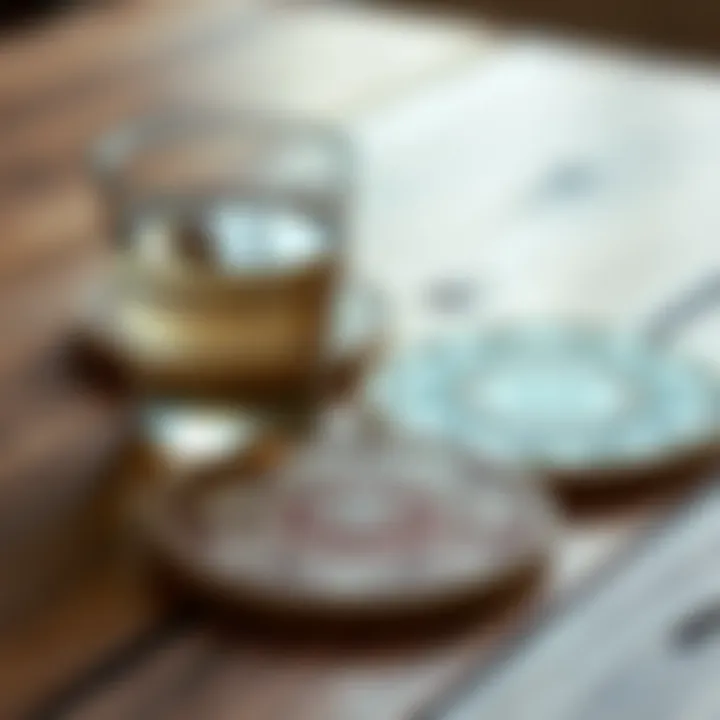
Techniques for Coaster Customization
Customizing coasters is more than just a fun endeavor; it’s a way to express creativity and make something truly personal. Each technique opens new doors for exploration, allowing crafters to turn a simple accessory into a statement piece. By honing specific skills in customization, you can transform an ordinary coaster into a treasured art piece or a fantastic gift. The techniques of decoupage, painting, and fabric application each bring distinct advantages and can cater to various tastes and styles.
Decoupage Methods
Decoupage is like telling a story through layers of paper. This technique allows you to apply images and decorations to your coasters in a way that gives them depth and personality.
Selecting Your Images
When selecting images for your coaster project, it’s important to think about what resonates with you. Whether it’s a beautiful landscape, a personal photo, or just some intriguing patterns, the imagery will ultimately set the tone for your creation. This choice is crucial as it showcases your personality and taste. A well-chosen image can transform a plain surface into a captivating focal point.
However, a drawback may come from choosing images that are too detailed or complex—the end result might be crowded and lose clarity during application. Ensure that your selected images fit well within the size of the coaster for an appealing look.
Layering Techniques
Layering is essential to decoupage. It involves placing one object over another, creating dimension. This technique enriches the visual depth of your coasters and can be as straightforward or elaborate as you wish. You can layer different images, patterns, or even textures to create a lively piece. It’s particularly beneficial for adding a personal touch that reflects your style.
That said, it does come with a caution. Over-layering can lead to a bulky or uneven finish, so it’s wise to maintain balance and proportion throughout the design.
Finishing Sealants
No one wants their hard work to wear out, which is where finishing sealants come into play. Sealants protect your coaster from moisture and scratches, ensuring longevity. They come in various finishes, like matte or glossy, allowing you to select one that matches your aesthetic preference. In this craft journey, sealants form a protective layer that enhances durability.
One potential downside to consider is the assembling process. Applying sealants might darken your images or change the texture slightly, so always test on a scrap piece first to make sure you get the effect you want.
Painting Techniques
Painting coasters is another popular path to customization that opens up a world of creativity. By choosing the right painting medium, you can tailor the appearance of your coasters according to your vision.
Acrylic vs Watercolors
Acrylics offer vibrant and opaque finishes, making them a popular choice among crafters. They dry quickly and are water-resistant when dry, ensuring durability for your coasters. On the other hand, watercolors, while often more translucent and soft in appearance, might not be as resilient to spills. Acrylics are more forgiving, allowing for bolder designs. The downside is that they can sometimes look overly flat if not layered correctly, whereas watercolors might create a softer, delicate charm that can be appealing yet less robust.
Brush Techniques
How you apply paint can have a significant impact on the final product. Different brush techniques, such as stippling or wash, add unique effects to your work. These techniques are beneficial for adding details such as textures or gradients. However, using the wrong brush for a specific effect could lead to unsatisfactory results. Experimentation is key here to find what techniques work best for your style.
Stenciling Ideas
Stencils offer a way to create sharp, clean designs easily. Stenciling can add repeating patterns or intricate images to your coasters with precision. This is particularly helpful for intricate designs that would be hard to paint freehand. The benefit of stenciling lies in its repeatability and clarity while ensuring a professional look.
Yet, on the flip side, it can restrict creativity if you rely solely on pre-made stencils. Feel free to make your own as well! Designing a custom stencil can be a fun addition to the crafting process.
Fabric and Textiles Application
Using fabric or textiles to decorate coasters adds a tactile quality that you simply won't find in paint or paper. Incorporating fabric can provide warmth and softness, making your coasters truly unique.
Choosing the Right Fabric
The fabric you choose will dictate not just the aesthetic but also the durability of the coaster. Natural materials, like cotton or linen, tend to absorb moisture better, while synthetics can offer more durability. The right fabric not only enhances style but also plays a crucial role in the coaster's functionality. The downside is that fabrics can wear out over time, particularly under heavy use, so it’s essential to consider how often your coasters will actually be used.
Attachment Techniques
When it comes to attaching fabric, methods like glue or sewing can be employed to secure the fabric to the coaster. Adhesive glue for fabrics ensures a seamless application while stitching provides a more permanent solution. Consider your project’s needs; each attachment technique offers benefits and can change the overall feel of your finished piece.
However, fabric can sometimes lead to a messy result if adhesives are applied inappropriately. Make sure the attachment method chosen enhances the beauty rather than detracts from it.
Finishing Edges
After adding fabric, finishing edges becomes essential to provide a polished look. Techniques like using bias tape or fabric glue to secure edges will give your coasters a neat appearance. Finishing edges ensures longevity, and prevents fraying, making your coasters more visually appealing and durable. However, this extra step takes time, so patience is key to achieving a professional finish.
Functional Crafting Ideas
Plain coasters are not just about protecting your furniture; they are a canvas brimming with potential for functional crafting. This section underscores the importance of creating items that are not only aesthetically pleasing but also practical in everyday life. By diving into this realm, crafters can add a personal touch to their environment while also gifting unique, handcrafted items that resonate with their recipients. Furthermore, functional items, such as coasters, imbue utility with creativity, seamlessly blending these dimensions into daily routines.
Creating Personalized Gifts
Customized Sets
Creating customized sets of coasters is a thoughtful approach to gift-giving that aligns perfectly with personal relationships. The charm of customized sets lies in their ability to speak to the receiver’s personality—whether it’s showcasing a favorite color palette, monograms, or intricate designs depicting shared memories. This tailored element makes them a popular choice, elevating the mundane act of using a coaster into a meaningful experience.
The unique feature of customized sets is their versatility. They can be designed for various occasions, from weddings to housewarmings. One of the main benefits of gifting customized coasters is the joy it brings, often serving as conversation starters or cherished keepsakes. However, it's important to ensure that the materials used are durable, as coasters see regular use, which can affect their longevity.
Themed Collections

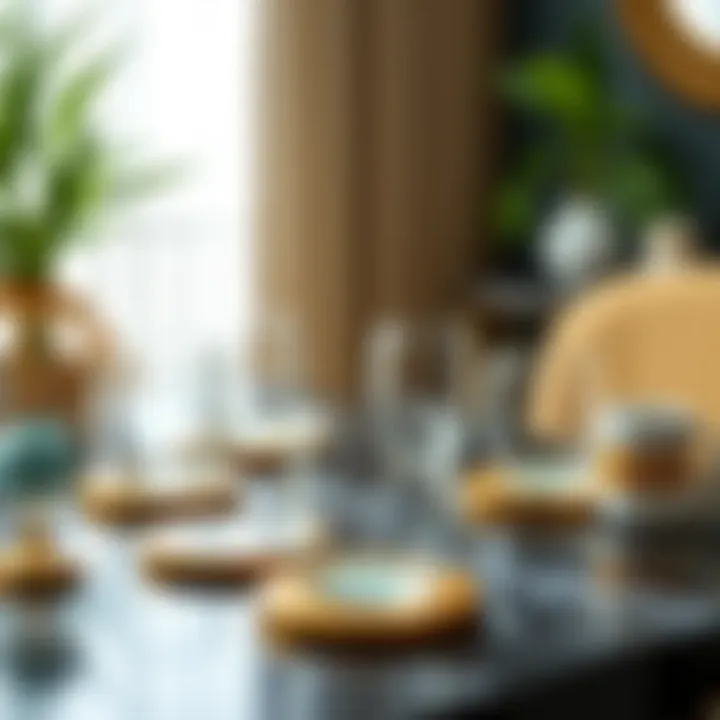
Themed collections take the idea of customization a notch higher by curating coasters around specific themes—be it holiday motifs, vintage styles, or even loved hobbies like gardening and cooking. Each collection tells a story, creating a cohesive aesthetic that can brighten up a space and reflect the owner’s interests. This personalized touch significantly contributes to the overall topic of crafting as it opens avenues for creativity and imagination.
A key characteristic of themed collections is their ability to transform ordinary coasters into curated pieces of art. Many find this approach beneficial as it allows for creativity while simultaneously enhancing the visual appeal of a room. Yet, crafting these collections requires careful consideration of design coherence and color matching, which can be complex for some crafters.
Special Occasions
Tailoring coasters for special occasions is another rewarding aspect of coaster crafting. Custom coasters can serve as memorable favors during events like birthdays, anniversaries, or even holidays. Imagine a BBQ party with coasters emblazoned with cheeky summer quotes or a wedding celebrating love with beautifully printed couple initials.
The appeal of special occasion coasters lies in their functional yet memorable nature. They can be both a practical accessory and a keepsake, providing dual purpose that resonates with attendees. However, careful thought is needed to match the occasion's spirit with the design, which means staying in tune with the festival's vibe, color schemes, and overall theme.
Home Decor Enhancements
Coaster Wall Art
One of the most inventive uses of coasters is transforming them into wall art. Coaster wall art can add a splash of color and interest to bare walls, making them a focal point of your home decor. By arranging coasters in visually appealing patterns or frames, they showcase creativity while serving as a conversation starter.
A highlight of coaster wall art is its ability to reflect both personality and style in a unique way. Homeowners can utilize different textures, colors, and designs to fit any room’s decor—from chic kitchen spaces to cozy living rooms. However, it’s important to consider the durability and adhesive methods used to ensure that the artwork remains intact over time.
Table Centerpieces
Centerpieces crafted from coasters bring an artistic flair to dining experiences. By stacking or arranging coasters creatively on tables, one can set an inviting atmosphere for gatherings. They can be complemented with candles or floral arrangements for heightened elegance, transforming the ordinary into the extraordinary.
The key characteristic of using coasters as table centerpieces is their ability to integrate functionality with decorative value. They catch spills while also enhancing the table's aesthetic appeal. The downside, however, might revolve around the coasters' design, which should be carefully considered to maintain balance with other decor elements on the table.
Seasonal Decorations
Incorporating seasonal decorations is a way to keep your crafting fresh and timely. Using plain coasters to represent various seasons through colors and themes—think pumpkin designs for autumn or snowflake patterns for winter holidays—can help elevate the atmosphere of a home during celebration times.
Highlighting the key characteristic of such decorations is their relatability to the time of year. Seasonal decorations can provide a quick makeover to your space, allowing crafters to express their creativity aligned with the rhythm of nature. However, these designs should be easy to switch out, ensuring that they do not crowd or clutter the space when it’s out of season.
Coaster Crafting for Sustainability
Crafting has always been more than just creating beautiful items; it often reflects our values and priorities. In today’s world, where environmental concerns loom large, incorporating sustainability into our crafting practices is crucial. Coaster crafting for sustainability allows artisans to explore unique methods that not only produce stunning pieces but also respect our planet. This section highlights sustainable practices, eco-friendly materials, and how these elements contribute to a healthier environment while making our coasters truly one-of-a-kind.
Eco-Friendly Material Choices
Recycled Materials
Using recycled materials can be a game changer in coaster crafting. It helps reduce waste and lowers the demand for fresh resources. You might find yourself using old magazines or leftover wood remnants, giving them a second chance at life. The key characteristic of recycled materials is their ability to bring a sense of history and uniqueness to every piece you create. An artist's touch with these materials results in coasters that are not just functional but hold a story within them. However, one should be aware that the quality might vary, and certain recycled products require extra care to ensure durability.
Sustainable Sourcing
When it comes to sourcing materials sustainably, it’s about finding suppliers who prioritize eco-friendly practices. Whether it’s sourcing bamboo or ethically harvested wood, sustainable sourcing speaks volumes about a crafter’s commitment to the environment. This practice minimizes deforestation and supports responsible forestry. A unique feature of sustainable sourcing is that many suppliers share their practices, allowing crafters to learn how their materials are produced. While this is a more upfront investment, the long-lasting quality and ethical stance can undeniably add value to your coasters.
Natural Fiber Options
Natural fiber options such as jute, cotton, or hemp are excellent choices for coaster crafting. These fibers are biodegradable, which means they will not contribute to landfill waste in the long run. Natural fibers are also breathable and often have a unique texture, enhancing the aesthetic of your coasters. Their versatility allows for various designs, from rustic to modern. However, it's important to note that these materials might be less durable than synthetic options, so proper care and maintenance are key. In the end, the environmental benefits outweigh the minor drawbacks.
Zero Waste Practices
Using Scraps Efficiently
Using scraps efficiently relates to maximizing every inch of material you have on hand. Instead of tossing leftover pieces away, consider how they might fit into your next project. This not only cuts down waste but also inspires creativity. One significant characteristic of this practice is the opportunity for innovation, as limitations can often spark new ideas. Although it might take an additional bit of planning, the result is always rewarding and aligns perfectly with sustainable crafting ideals.
Reusing Coasters
Instead of discarding old coasters that may have seen better days, think creatively about how to give them new life. Perhaps a coat of paint or a bit of decoupage can transform a worn-out piece into something reminiscent of artisanal craftsmanship. Reusing coasters can save money and resources, plus it's a unique form of personal expression. While some may find this labor-intensive, the satisfaction of making something old new again is hard to beat.
Minimizing Environmental Impact
Minimizing environmental impact doesn’t solely entail using eco-friendly materials; it's about adopting a holistic view of crafting. Implementing practices like using non-toxic glues and paints or committing to energy-efficient tools makes a difference. The key here is awareness — understanding how each decision affects the planet. That being said, while some materials might be more expensive initially, the long-term benefits, both to your craft and the environment, make it worthwhile.
Advanced Coaster Crafting Techniques
When it comes to crafting with coasters, it’s easy to assume that the possibilities are limited. However, taking a step into advanced coaster crafting can really open up a world of creativity. Exploring various techniques not only adds depth to your projects but also enhances your ability to express individuality. In this section, we will look into mixed media applications and interactive designs. These techniques offer new perspectives on functionality and aesthetics, paving the way for standout creations.
Mixed Media Applications
Combining Different Materials
A hallmark of mixed media applications is the ability to blend various materials, turning humble coasters into unique artistic statements. Combining different materials, such as wood, cork, and fabric, allows crafters to tap into the characteristics of each, creating a visually stimulating effect. This melding heightens the overall aesthetic appeal and can be quite advantageous when you're aiming for creativity that speaks volumes.
For instance, a cork base combined with a painted wooden top may lend a rustic feel, while integrating metals can evoke a contemporary vibe. The unique feature of this approach lies in its adaptability; crafters can experiment with textures and designs to suit their specific taste. However, it’s crucial to consider how each material interacts; some adhesives may work wonders with one type but fail dramatically with another.
Unique Textures
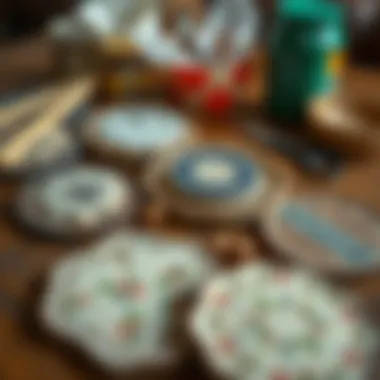
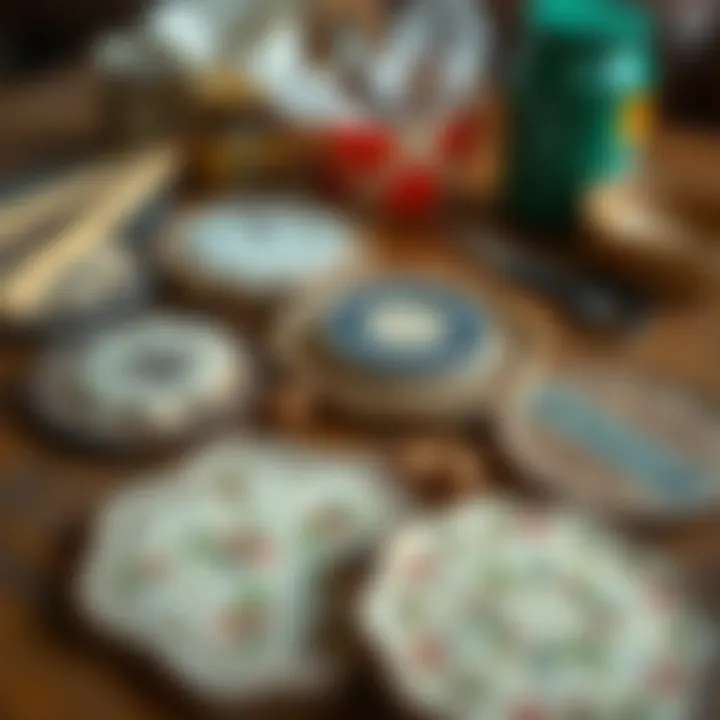
Textures play a critically important role in crafting. Using unique textures enhances the tactile quality of coasters, engaging users both visually and touchably. Whether it’s the smoothness of polished stone or the warmth of soft fabric, textures create layering opportunities that invite exploration.
Incorporating unique textures is a popular choice because it adds dimension to relatively simple items. Picture a coaster that combines a gritty jute backing with a glossy resin finish—the contrasting sensations can draw attention and spark conversations. Yet, while experimenting with textures, keep in mind the physical weight and balance; certain materials may lead your coaster to wobble or tip.
Layering Techniques
Layering techniques hold a special charm in coaster crafting. Through this technique, crafters can build visual depth and storytelling into their designs. It’s an effective way to create a narrative or convey a theme through overlapping images and colors.
The main attribute that makes layering appealing is its sheer versatility. A layered coaster can feature various elements, from photographs to printed papers or even organic materials like dried flowers. As layers interact, they form shadows and highlight aspects differently, yielding dynamic outcomes. However, it’s prudent to consider drying times and adhesive strengths when layering, as improper techniques can lead to unsightly finishes.
Interactive and Functional Designs
With interactive designs, coasters can evolve from simple surfaces to multifunctional art pieces. This grants crafters the chance to innovate and produce pieces that not only serve their purpose but also engage users in unexpected ways.
Coasters with Built-In Storage
Imagine coasters doubling as ingenious storage solutions. Coasters with built-in storage capitalize on space and practicality. This feature might include a slot for small items like keys or sugar packets, merging function with fun. Such designs are a favorite among those who appreciate convenience in creative items.
The beauty of coasters with storage is that they tackle clutter while providing style. Their unique merging of practicality and aesthetics makes them a standout option. However, one must consider the structural integrity—ensuring the coaster remains sturdy while accommodating storage elements.
Game Coaster Sets
Introducing an element of play, game coaster sets create a delightful experience for users. These coasters not only protect surfaces but also contribute to interactive sessions. Utilizing each coaster as a piece of a game can forge new ways to gather, especially in social settings.
The key characteristic here is engagement; they provide a conversational element that can stir nostalgia or introduce new games to players. However, the designs must be carefully thought out to ensure they are easy to understand and use, otherwise frustration can stem from poor functionalities.
Convertible Coasters
Convertible coasters take versatility up a notch by serving multiple purposes. They can switch between normal coasters and decorative items or other useful tools. This adaptability adds a practical layer to crafting, allowing crafters to fuse creativity with everyday utility.
One strong point of convertible coasters is their capacity to thrill users through surprise transformations. An unfortunate downside, however, could be the complexity in crafting—achieving durability alongside functionality often requires advanced skills and careful selection of materials.
Exploring these advanced techniques not only broadens your crafting horizons but also cultivates a unique personal style. This journey into the creative uses of plain coasters opens a floodgate of opportunities to express oneself and enhance daily life through art.
Showcasing Your Craftsmanship
In the world of crafting, the way you present your work can make a significant difference—not just in how it’s perceived, but in how far it can reach. Showcasing your craftsmanship isn’t merely about displaying your finished product; it's about telling the story of your creative process. The importance of this section lies in the understanding that visually representing your work is crucial for recognition, whether you are aiming to attract clients, collaborate with other artisans, or simply share your passion with an audience.
A well-curated showcase can enhance the appeal of your coasters, turning a simple item into a conversation starter. Craft enthusiasts and boutique owners alike benefit from strategies that effectively highlight their artistry. It’s not just about putting the coasters on display but doing so in a way that elevates their value in the eyes of potential buyers.
Photography Tips for Final Products
Lighting Considerations
Good lighting is the backbone of any photography endeavor. The right lighting can amplify colors, enhance textures, and bring out the finer details in your coaster designs. Natural light, especially during golden hours—early morning or late afternoon—offers a soft, warm glow that can make your coasters look inviting.
Consider using reflectors to bounce light onto your coasters, removing harsh shadows while adding depth. Although professional lighting setups can yield fantastic results, they might not be accessible to everyone. Luckily, softboxes and inexpensive LED lights can be a game-changer, too. They help control the lighting environment, but they won't give that same natural vibe as direct sunlight does.
One common mistake is overexposing shots, leading to lost detail. Instead, experiment with different levels of brightness and adjustments until you find the sweet spot. Remember, shadows and highlights also tell a story.
Backdrop Options
The backdrop for your photos plays a pivotal role in how the coasters are perceived. An appropriate backdrop draws attention to the crafted item without overwhelming it. Clean, neutral colors like white or light gray are often recommended to create a fresh look that allows the coasters to stand out.
However, textural backdrops like wood or linen can add an interesting visual element when appropriate. For instance, a rustic wooden table can enhance the charm of wooden coasters, connecting them to their material roots. While it's tempting to use busy patterns, remember that the focus should remain on your craftsmanship. A backdrop should support, not distract, from the work you’ve done.
Editing Tools
Editing is an essential part of presenting your work in the best possible light—quite literally. Different editing tools can enhance your photos, correcting exposure, adjusting colors, and cropping to emphasize key aspects of your coaster designs. Tools like Adobe Lightroom and Canva offer a wide range of capabilities, allowing you to refine your images effortlessly.
Free editing solutions also exist like GIMP or Pixlr for those on a budget, offering many features catering to photo enhancement needs. The goal isn't necessarily to create an artificial look, but rather to achieve a polished representation of your craftsmanship. Always remember to keep your images true to life, ensuring that colors and textures featured in your photos mirror what buyers can expect in person.
Promoting Your Work
Utilizing Social Media
In today's digital age, promoting your work through social media platforms is not optional, it's a necessity. Instagram, in particular, is a fountain of opportunity, allowing crafters to showcase their creations visually. Use images that narrate your creative journey or short videos demonstrating the crafting process, as these can forge a deep connection with your audience.
Hashtags, when used wisely, can extend your reach considerably, helping your coasters find their way to those interested in custom crafts. Be actively engaged—comment, like, and share relevant posts within your niche. You never know when one connection might lead to a collaboration or a new customer.
Building an Online Portfolio
An online portfolio serves as a dynamic showcase of your work, consolidating all your achievements in one place. This can be a personal website or a dedicated store on platforms like Etsy or Shopify, both excellent for gaining traction and visibility.
Your portfolio should not only include high-quality images of your coasters but also descriptions that tell the story behind each creation. Every detail counts—material choices, the inspiration behind the design, or the techniques used. Additionally, being able to present a professional online presence enhances credibility, which is crucial when enticing potential buyers.
Participating in Local Craft Shows
Local craft shows provide an excellent opportunity to showcase your coasters in tangible form while networking with like-minded individuals. Being physically present allows you to engage with potential customers, answer questions, and gather feedback in real time, which is invaluable.
Craft shows also offer the chance to see what others in your field are doing, allowing for ideas and inspiration to flow. Make sure your display reflects your brand’s aesthetic, inviting people to stop by and learn more. While the effort of setting up might seem daunting, the potential to increase local visibility and forge connections is well worth the effort.
